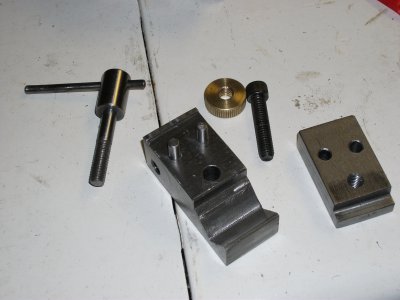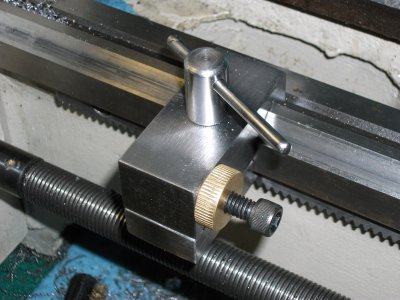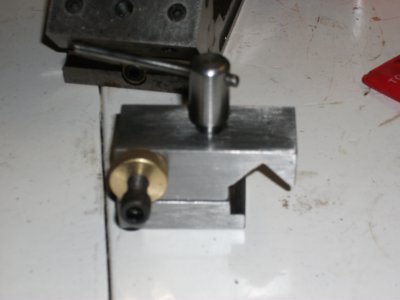-
Welcome back Guest! Did you know you can mentor other members here at H-M? If not, please check out our Relaunch of Hobby Machinist Mentoring Program!
You are using an out of date browser. It may not display this or other websites correctly.
You should upgrade or use an alternative browser.
You should upgrade or use an alternative browser.
Quick Carriage stop
- Thread starter markknx
- Start date
- Joined
- Feb 22, 2012
- Messages
- 924
Very nice! I like the release mechanism.
not a stupid question at all - this is a manual stop. not intended for power feed so no e-stop switch required. the way it works is you power feed the carriage. when the carriage is close enough to the end of it's travel (for the particular cut) and is nearing contact with the stop you disengage power feed, and finish the cut by hand - in which case you turn the carriage until it hits the stop.
Please forgive a stupid question but how does this work? It would seem to me the right way to do it would involve an e-stop switch. I am obviously needing to learn more on this because I need one too.
not a stupid question at all - this is a manual stop. not intended for power feed so no e-stop switch required. the way it works is you power feed the carriage. when the carriage is close enough to the end of it's travel (for the particular cut) and is nearing contact with the stop you disengage power feed, and finish the cut by hand - in which case you turn the carriage until it hits the stop.
The reason for my stupid question arose from me threading an 8 tpi internal thread the other day. Even in back gear at 50 rpm with a low thread count the carriage moves quickly and you have to be very quick on the halfnut to avoid hitting something. I guess this stop was not intended to address that situation.
It would seem that it wouldn't be too hard to design an adjustable stop with an e-stop switch mounted on a spring loaded probe that allows enough travel to adequately stop the lathe in back gear. Has anyone ever heard of something like this or done it themselves?
It would seem that it wouldn't be too hard to design an adjustable stop with an e-stop switch mounted on a spring loaded probe that allows enough travel to adequately stop the lathe in back gear. Has anyone ever heard of something like this or done it themselves?
- Joined
- Feb 22, 2012
- Messages
- 924
The reason for my stupid question arose from me threading an 8 tpi internal thread the other day. Even in back gear at 50 rpm with a low thread count the carriage moves quickly and you have to be very quick on the halfnut to avoid hitting something. I guess this stop was not intended to address that situation.
It would seem that it wouldn't be too hard to design an adjustable stop with an e-stop switch mounted on a spring loaded probe that allows enough travel to adequately stop the lathe in back gear. Has anyone ever heard of something like this or done it themselves?
an e-stop can be included in a carriage stop, but obviously it will be a bit more complex as it needs to shut off and brake the spindle/gears immediately.
That said - for threading control you can do one of the following to avoid running into a shoulder:
1. cut a relief cut at the end of the threaded part so you don't have to thread all the way to the shoulder
2. thread from left to right (carriage moves from headstock to tailstock) - that way you start at the shoulder, and never have to worry about hitting anything. keep in mind to stay with a LH or RH thread you would need to position the cutter accordingly when moving in "reverse"
- Joined
- Nov 16, 2012
- Messages
- 5,596
All,
Be careful with these things. They're mainly intended for hand-wheel operation of the carriage. Some lathes have a leadscrew and a driverod. If the leadscrew is engaged and you hit the carriage stop somthing is going to get damaged. With any luck, the shear pins will break. Some (but not all) lathes with driverods have a slip-clutch engagement that pushes the carriage but won't break things if the carriage hits a stop. I still wouldn't rely on that as a regular practice.
On my old Atlas, I made a carriage stop with an electrical switch that operated a solenoid to disengage the half-nut lever. Been half-tempted to convert it over to my Precision Matthews.
BTW: Some PM machines have slip-clutch driverods and some do not. 1236 e.g. does not.
Ray
- - - Updated - - -
Dead-on Sharon... This is the way to do it. It's basically a "reverse left-hand thread". FWIW, I always cut a shoulder relief about 0.002 greater in diameter than my intended thread depth. When the thread bit first hits that clean area, you know you're almost home. When the threads are done, throw the groover at it and clean-up the scratches.
Also worth noting that for screw-on chucks, you need to be careful running in reverse.
Ray
Be careful with these things. They're mainly intended for hand-wheel operation of the carriage. Some lathes have a leadscrew and a driverod. If the leadscrew is engaged and you hit the carriage stop somthing is going to get damaged. With any luck, the shear pins will break. Some (but not all) lathes with driverods have a slip-clutch engagement that pushes the carriage but won't break things if the carriage hits a stop. I still wouldn't rely on that as a regular practice.
On my old Atlas, I made a carriage stop with an electrical switch that operated a solenoid to disengage the half-nut lever. Been half-tempted to convert it over to my Precision Matthews.
BTW: Some PM machines have slip-clutch driverods and some do not. 1236 e.g. does not.
Ray
- - - Updated - - -
Dead-on Sharon... This is the way to do it. It's basically a "reverse left-hand thread". FWIW, I always cut a shoulder relief about 0.002 greater in diameter than my intended thread depth. When the thread bit first hits that clean area, you know you're almost home. When the threads are done, throw the groover at it and clean-up the scratches.
Also worth noting that for screw-on chucks, you need to be careful running in reverse.
Ray
an e-stop can be included in a carriage stop, but obviously it will be a bit more complex as it needs to shut off and brake the spindle/gears immediately.
That said - for threading control you can do one of the following to avoid running into a shoulder:
1. cut a relief cut at the end of the threaded part so you don't have to thread all the way to the shoulder
2. thread from left to right (carriage moves from headstock to tailstock) - that way you start at the shoulder, and never have to worry about hitting anything. keep in mind to stay with a LH or RH thread you would need to position the cutter accordingly when moving in "reverse"
- Joined
- Dec 22, 2011
- Messages
- 715
As Sharon said, you need to have a relief at the end of the thread so you have some margin of safety to stop before crashing. The other thing I do is use a dial indicator. The carriage stop that I made isn't threaded for the actual stop. It's bored 3/8" and has a clamp bolt so I can either put a piece of 3/8" drill rod in it for a stop, or put the DI in it. It's pretty easy to measure where your relieve groove is, then just watch the DI to know when to disengage the half nuts.
Hope that helps.
Steve
Hope that helps.
Steve
The reason for my stupid question arose from me threading an 8 tpi internal thread the other day. Even in back gear at 50 rpm with a low thread count the carriage moves quickly and you have to be very quick on the halfnut to avoid hitting something. I guess this stop was not intended to address that situation.
It would seem that it wouldn't be too hard to design an adjustable stop with an e-stop switch mounted on a spring loaded probe that allows enough travel to adequately stop the lathe in back gear. Has anyone ever heard of something like this or done it themselves?




